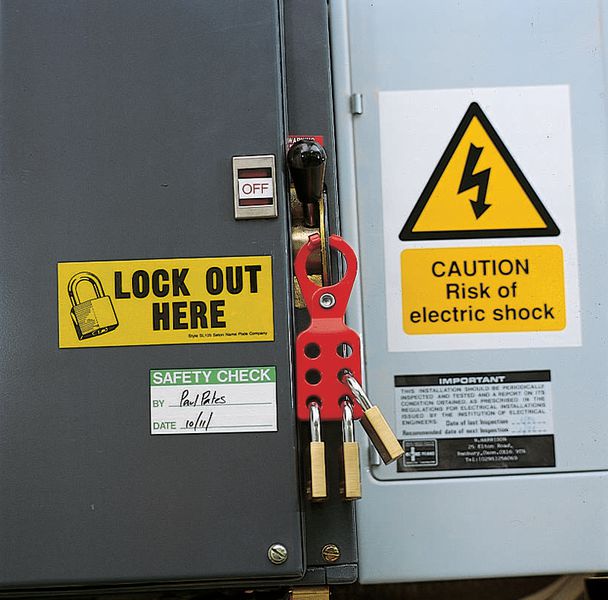-

Safety Lockout Hasps
From £9.99 To £201.05Supplied in: Single -

Labelled Lockout Hasps with Remarks Section
£109.99Supplied in: Pack of Five -

High-Visibility Non-Conductive 6 Padlocks Lockout Hasp
£9.99Supplied in: Single -

Stainless Steel Lockout Hasp
£19.99Supplied in: Single -

Labelled Lockout Hasps with Name and Department Section
From £109.96 To £109.99Supplied in: Pack of Five -

Dual Safety Hasps
From £49.99 To £53.99Supplied in: Single -
New

Labelled Lockout Hasp with No Text
£59.99Supplied in: Pack of Five -
New

Stainless Steel Scissor Action Hasp
£13.22Supplied in: Single -

Flexible Lockout Hasps
£9.99Supplied in: Single -

Brady Safety Aluminium Lockout Hasps
£88.99Supplied in: Pack of 5 -

Economy Lockout Hasp
£7.99Supplied in: Single -

Safety Lockout Hasps With Chain
£7.99Supplied in: Single -

Plastic Lockout Hasp
£19.99Supplied in: Single -

High-Visibility Lockout Hasps
£110.99Supplied in: Pack of 12 -

Padlock Caddy
£44.99Supplied in: Single
Lockout Hasps
Need help?
 Why do I need a Lockout Hasp?
Hasps are an integral part of any lockout tagout procedure as you will often find that you will need to use hasps for an effective multi-person repair or maintenance team. The function of hasps is to be used by multiple people, they take multiple padlocks and allow an energy source to be locked out by more than one person.
Why do I need a Lockout Hasp?
Hasps are an integral part of any lockout tagout procedure as you will often find that you will need to use hasps for an effective multi-person repair or maintenance team. The function of hasps is to be used by multiple people, they take multiple padlocks and allow an energy source to be locked out by more than one person.
Essentially meaning that each machine locked out with a hasp will not be able to be re-engaged until each individual worker removes their padlock from the hasp. A hasp should be a part of every lockout procedure, it is a vital piece of hardware.
Also discover:
Lockout tagout
An Essential Addition to Your Lockout Process
In order to comply with health and safety regulations in the work place, when deactivating machinery for repair, maintenance or inspection, you must have adequate lockout procedures in place to ensure your workers safety. Hasps are a vital part of any lockout kit, as such use our categories to ensure that they are utilised in your lockout procedures.
The best use for hasps is being attached to the primary isolator when applying lockout devices, to isolate the power of machinery. Then, workers attach their personal padlock each in turn, depending on how many personnel have to complete tasks on the machine to complete the work. Each hasp usually holds six padlocks as this is a good average size of a maintenance team but even one padlock will fully secure the hasp in place. Due to its essential nature it is a part of almost all of our lockout kits, these kits are a good place to start after completing your lockout procedure.
The function of having more than one padlock engaged at one time is to let others, namely unauthorised employees and people working on the machine, know how many people are involved in the work at one time and when they are performing repair and maintenance functions. It also acts as a simple safety system, in place to stop people from engaging the machinery before the work is complete, you can even use colour coded padlocks given to specific employees so that they can see in an instant who is carrying out work and who is finished.
A Variety of Hasp Materials
When using hasps to lock out circuit breakers or any equipment with the risk of electrical injury you will want to consider using non-conductive plastic hasps, these are made of strong plastics and in some cases plastics that are extremely flexible, that cannot be easily broken apart whether from accident or intent.The other main type of hasp that we offer are metal hasps. These are hard wearing and great for use in industrial areas, these types of hasp are the more common one you will come across in lockout kits as they can generally be used in more applications and offer greater security.
There are many and varied types of hasps to choose from, to increase safety when applying hasps consider a larger hasp with enough surface area to put a warning or prohibition label on it. This is a simple way to let others know of the consequences of tampering with the hasp or removing padlocks without authorisation. Another way to ensure vital information is displayed especially on smaller hasps is by using lockout tags, these can be attached by a simple cable tie to a padlock or in the loop of the has or padlock itself, simple steps that can be taken to increase safety. Communication and information are key in any lockout process.
